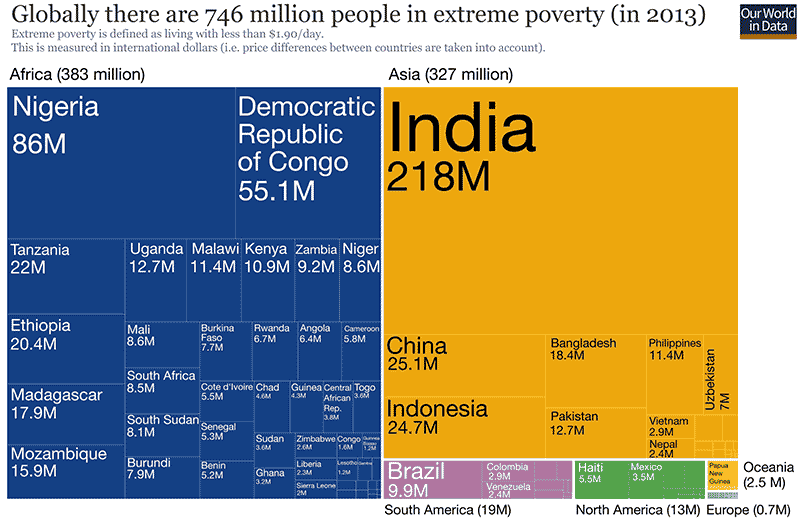What The Fact?
Does $1.90 a day keep global poverty away?
Photo: ‘Discovery’ © World Bank Photo Collection via Flickr used under CC BY-NC-ND 2.0
- Colm Regan
- June 13, 2019
The Claim
There has been marked progress on reducing poverty over the past decades. The world attained the first Millennium Development Goal target – to cut the 1990 poverty rate in half by 2015 – five years ahead of schedule, in 2010.
Despite the progress made in reducing poverty the number of people living in extreme poverty globally remains unacceptably high. And given global growth forecasts, poverty reduction may not be fast enough to reach the target of ending extreme poverty by 2030. According to recent estimates:
- By 2015, 10 percent of the world’s population lived on less than US$1.90 a day, compared to 11 percent in 2013. That’s down from nearly 36 percent in 1990.
- Nearly 1.1 billion fewer people are living in extreme poverty than in 1990. In 2015, 736 million people lived on less than $1.90 a day, down from 1.85 billion in 1990.
Is it still possible for the World Bank to meet its goal to reduce extreme poverty to 3% (or less) by 2030?
“It is, but it will not be easy. In the face of a global economic slowdown, it will be even more difficult for people to move out of extreme poverty and continue upward.”
Source: World Bank and Poverty Line Update, Sept 2015 World Bank
The Verdict

The argument offered by the World Bank on world poverty is misleading on three levels.
1. Defining absolute poverty at $1.90 per day is far too low, even for people in the least developed countries, let alone those in Latin America and large parts of Asia.
2. This figure of $1.90 allows the Bank to claim that the number of absolute poor in the world is far lower than it is in reality.
3. Arguing that with the ‘right’ policies and strategies, we can eradicate absolute poverty by 2030 is impossible especially if environmental limits are factored in.
The Evidence
The two statements above are directly taken from the poverty overview section of the World Bank website. They summarise the data around which a major debate on world poverty revolves, a debate not just on how to define and measure it but also on when it eradicated.
- For decades, the standard shorthand definition of absolute poverty was US$1 per day (roughly equivalent to the national poverty lines in the 22 countries used in 1990 to build the database). Given the many very serious weaknesses in the data (how it was collected and how reliable the numbers were), the US$1 per day was always contested and many insisted it was so low, it was meaningless.
- The international poverty line was re-defined by the World Bank in 2008 (at US$1.25 per day) and in 2015 (at $US1.90 per day – the average poverty line in the poorest countries) to reflect the cost of a bundle of goods across all countries. The Bank argued that the new figures better reflected reality. Again, many critics argued the figures were way too low to be meaningful.
- On the basis of the above World Bank figures, in 2015 just over 10% of the world’s people lived on less than US$1.90 a day, compared to just over 11% 2013 and the Bank claims down from nearly 36% in 1990.
- In absolute terms, this suggests that 1.1 billion fewer people are living in extreme poverty than in 1990.
For an excellent summary of the data and the debate, see the Our World in Data essay.
Again, this assertion and the data it is based on are the subject of considerable debate and disagreement.
- Critics argue that $US1.90 per day enables the Bank to argue that the figures of those in poverty are lower than they actually are. The redefinition in 2015 reduced the numbers of the poor overnight by some 100 million.
- US$6 per day is deemed to be far more accurate as a realistic poverty line in the countries of Latin America, for example.
- For many NGO and academic critics, US$1.90 is simply not realistic and that US$5 – 7 per day better reflects the realities of poverty.
- On the basis of the above poverty levels (US$5-7 per day), the numbers living in poverty would reach as high as 4.2 billion – a level very significantly different to that of the World Bank.
So, on the basis of the debate above, the numbers living in poverty would vary between 736 million and 4.2 billion – a very large discrepancy.
On this dimension of the debate, see the arguments of UNCTAD economist David Woodward.
Historical data

Regarding historical data, it is important to note the following:
- In 1820 there were just under 1.1 billion people in the world, of which more than 1 billion lived in extreme poverty, as then defined
- Over the next 150 years, the decline of poverty was not fast enough to offset the rapid rise in world population, so the number of non-poor and poor increased.
- From around 1970 the number of non-poor people has risen considerable while the number of poor people has fallen (again, based on the contested definition)
- There were an estimated 2.2 billion people living in extreme poverty in 1970 while the figure today is 736 million.
Again, on the basis of the official definition of poverty, the number of extremely poor people in the world is 3 times lower than it was in 1970. There can be little doubt that the numbers of absolutely poor in the world declined significantly in the past 5 decades BUT that decline has been regionally very uneven.
'Multidimensional' poverty
Given the criticisms of measuring poverty simply by a (debatable) income level, the United Nations Development Programme created, in 2010, an index of multidimensional poverty. This index goes beyond income and looks at how people actually experience poverty in many ways. It focuses on how people are left behind in three key dimensions – health, education and standard of living. Those who experience deprivation in at least one third of these indicators fall into the category of the multi-dimensionally poor.
The latest 2018 Index can be accessed here: https://hdr.undp.org/en/2018-MPI
2030, 2115 or 2222?
The debate on poverty in the world also includes a debate on when it might be eradicated and, again, there is little agreement.
- The SDG agenda aims to eradicate absolute poverty (defined at US$1.25 per day) by 2030. Given the most optimistic of economic growth rates and the reality of environmental limits to ever increased economic growth, many critics argue that the date is impossible to achieve.
- Critics argue that at current rates of growth, it would take 100 years to eradicate poverty at the US$1.25 per day rate. At a rate of US$5 per day, it would take 207 years.
- The reality is that global GDP would have to increase 175 times if we were to achieve success in eradicating poverty defined at US$5 per day, something almost everyone agrees is utterly impossible.
Again, see the arguments of UNCTAD economist David Woodward and those of anthropologist Jason Hickel.
Conclusion
We need to remember that even at the lowest level of absolute poverty definition, there are at least 736 million people across the world struggling to survive at the most basic level in a world that has never been richer.
On this debate, see the arguments of the United Nations Special Rapporteur on Extreme Poverty and Human Rights, Philip Alston.
Sources
- FAQs: Global Poverty Line Update by the World Bank, September 2015
- Global Extreme Poverty by Max Roser and Esteban Ortiz-Ospina, Our World In Data, March 27, 2017
- Incrementum ad Absurdum: Global Growth, Inequality and Poverty Eradication in a Carbon-Constrained World by David Woodward, UNCTAD, in World Economic Review journal issue 4: 43-62, 2015
- The 2018 Global Multidimensional Poverty Index (MPI), Human Development Reports, UNDP, 2018
- Bill Gates says poverty is decreasing. He couldn’t be more wrong by Jason Hickel in The Guardian, January 29, 2019
- Special Rapporteur on extreme poverty and human rights on Office of the UN High Commissioner for Human Rights
_______________
developmenteducation.ie’s What The Fact? supports the code of principles of the International Fact Checking Network. We check claims by influencers, from local to national to transnational that relate to human rights and international human development.
Transparent fact checking is a powerful instrument of accountability, and we need your help.
Send tips and ideas to facts@developmenteducation.ie
Join the conversation #whatDEfact on Twitter @DevEdIreland and Facebook @DevEdIreland
